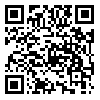Sat, Oct 26, 2024
[Archive]
Volume 16, Issue 3 (7-2024)
itrc 2024, 16(3): 35-44 |
Back to browse issues page
Download citation:
BibTeX | RIS | EndNote | Medlars | ProCite | Reference Manager | RefWorks
Send citation to:



BibTeX | RIS | EndNote | Medlars | ProCite | Reference Manager | RefWorks
Send citation to:
Sarlakifar F, Mahdavi Mortazavi M, Shamsfard M. EmoRecBiGRU: Emotion Recognition in Persian Tweets with a Transformer-based Model, Enhanced by Bidirectional GRU. itrc 2024; 16 (3) :35-44
URL: http://journal.itrc.ac.ir/article-1-653-en.html
URL: http://journal.itrc.ac.ir/article-1-653-en.html
1- Faculty of Computer Science and Engineering, Shahid Beheshti University, Tehran, Iran
2- Faculty of Computer Science and Engineering, Shahid Beheshti University, Tehran, Iran ,m-shams@sbu.ac.ir
2- Faculty of Computer Science and Engineering, Shahid Beheshti University, Tehran, Iran ,
Abstract: (1302 Views)
Emotion recognition in text is a fundamental aspect of natural language understanding, with significant applications in various domains such as mental health monitoring, customer feedback analysis, content recommendation systems, and chatbots. In this paper, we present a hybrid model for predicting the presence of six emotions: anger, disgust, fear, sadness, happiness, and surprise in Persian text. We also predict the primary emotion in the given text, including these six emotions and the “other” category. Our approach involves the utilization of XLM-RoBERTa, a pre-trained transformer-based language model, and fine-tuning it on two diverse datasets: EmoPars and ArmanEmo. Central to our approach is incorporating a single Bidirectional Gated Recurrent Unit (BiGRU), placed before the final fully connected layer. This strategic integration empowers our model to capture contextual dependencies more effectively, resulting in an improved F-score after adding this BiGRU layer. This enhanced model achieved a 2% improvement in the F-score metric on the ArmanEmo test set and a 7% improvement in the F-score metric for predicting the presence of six emotions on the final test set of the ParsiAzma Emotion Recognition competition.
Keywords: Emotion Recognition (ER), Bidirectional Gated Recurrent Unit (BiGRU), Natural Language Processing (NLP), Large Language Model (LLM)
Type of Study: Research |
Subject:
Information Technology
Send email to the article author
| Rights and permissions | |
 | This work is licensed under a Creative Commons Attribution-NonCommercial 4.0 International License. |




